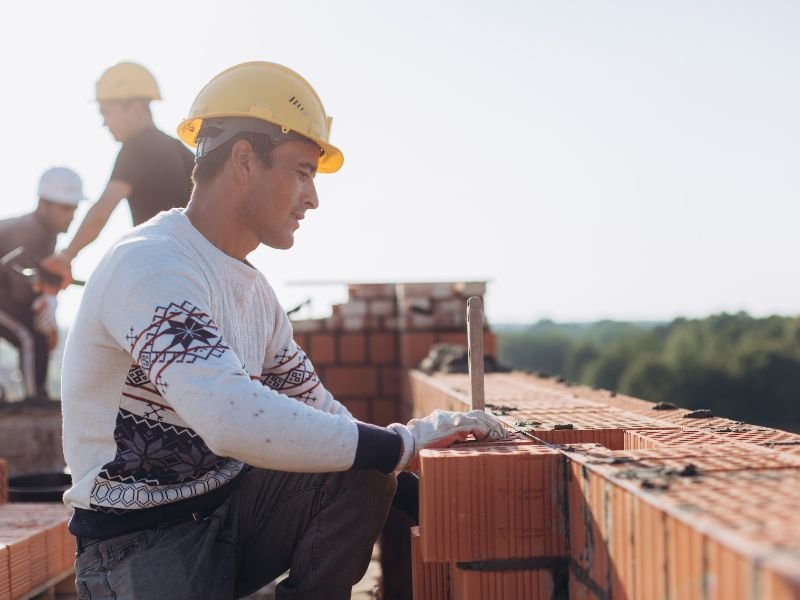Australia’s booming construction industry offers excellent opportunities for skilled foreign workers seeking stable employment and competitive wages. With an increasing demand for infrastructure projects, housing developments, and commercial construction, the country continues to rely on overseas labour to fill critical skill shortages. As a result, the salary for foreign construction workers in Australia has become an important topic for those considering a career in this sector.
Foreign workers can expect attractive salaries, particularly in high-demand trades such as electricians, welders, and heavy equipment operators. However, wages vary based on factors like job role, location, experience, and employer demand. Additionally, understanding visa requirements, licensing processes, and workplace expectations is essential for those planning to work in the Australian construction industry.
Salary For Foreign Construction Workers In Australia
Australia’s construction industry is a key pillar of the national economy, contributing significantly to employment and infrastructure development. The sector encompasses a wide range of activities, including residential, commercial, industrial, and civil engineering projects. As of 2025, the construction industry remains a major driver of economic growth, fueled by ongoing urbanization, population expansion, and government infrastructure investments.
1. Industry Growth and Demand for Workers
Australia’s construction sector has experienced steady growth over the past decade, with demand for skilled labor remaining high. Several factors contribute to this demand, including:
- Major Infrastructure Projects: The Australian government continues to invest heavily in transport, energy, and public infrastructure projects. Initiatives such as road expansions, rail networks, and renewable energy installations have created thousands of job opportunities for construction workers.
- Housing Market Expansion: A growing population and increased demand for affordable housing have led to a surge in residential construction. The sector has seen a rise in new housing developments, apartment complexes, and renovations.
- Post-Pandemic Recovery: Following the disruptions caused by the COVID-19 pandemic, the construction industry has rebounded strongly, with government stimulus packages and incentives driving new projects.
2. Employment Opportunities for Foreign Workers
Due to persistent labor shortages, foreign workers have become an essential part of Australia’s construction workforce. Tradespeople, engineers, and laborers from overseas are frequently recruited to fill skill gaps. Skilled foreign workers are particularly needed in the following areas:
- Carpentry and Joinery
- Plumbing and Electrical Work
- Welding and Metal Fabrication
- Civil and Structural Engineering
- Heavy Equipment Operation
- Project Management and Site Supervision
Workers with experience in these trades can find well-paying job opportunities, especially in high-demand locations such as Sydney, Melbourne, Perth, and Brisbane.
3. Regional vs. Urban Construction Markets
The demand for construction workers varies between metropolitan areas and regional locations.
- Urban Areas: Major cities like Sydney, Melbourne, and Brisbane offer higher salaries and more job opportunities, but they also have higher living costs. Large-scale commercial and infrastructure projects dominate urban construction markets.
- Regional and Remote Areas: Rural and remote regions often struggle to attract skilled workers, leading to higher wages and incentives for those willing to relocate. In areas like Western Australia and Northern Queensland, mining and resource-related construction projects are particularly active.
4. Industry Challenges and Workforce Issues
Despite strong growth, Australia’s construction industry faces several challenges:
- Labor Shortages: A lack of skilled workers continues to be a major issue, leading to increased reliance on foreign workers through visa programs.
- Material Costs and Supply Chain Disruptions: Fluctuations in material costs and supply chain issues can impact project timelines and budgets.
- Regulatory Compliance: Strict safety and labor laws require employers and workers to comply with national standards, ensuring workplace safety and fair wages.
- Union Influence: Construction unions in Australia, such as the CFMEU (Construction, Forestry, Maritime, Mining, and Energy Union), play a significant role in shaping wages and working conditions.
5. Future Outlook
The future of Australia’s construction industry remains positive, with continued investment in infrastructure and housing. The government’s push for renewable energy projects and smart city initiatives is expected to drive further job creation. Foreign workers with relevant skills will continue to play a critical role in meeting the industry’s workforce demands.
For foreign construction workers, Australia presents an attractive destination with competitive salaries, stable job opportunities, and a well-regulated work environment. Understanding the industry landscape can help job seekers make informed decisions about their career prospects in Australia.
Salary Expectations for Foreign Construction Workers in Australia
Foreign construction workers in Australia can expect competitive salaries that vary based on job role, experience, location, and demand for specific trades. With labor shortages across the sector, skilled foreign workers often earn wages comparable to, or sometimes even higher than, their Australian counterparts.
1. Factors Influencing Salaries in the Construction Industry
Several key factors determine salary levels for construction workers in Australia:
- Job Role and Skill Level – Skilled trades like electricians, welders, and project managers typically earn higher wages than general laborers.
- Experience – Workers with extensive experience or specialized training command better salaries.
- Location – Jobs in metropolitan areas like Sydney and Melbourne may offer higher wages, but remote locations often provide additional incentives due to labor shortages.
- Union vs. Non-Union Worksites – Unionized workers often receive better pay and benefits compared to non-unionized workers.
- Economic Conditions – Demand for construction workers fluctuates based on government spending, housing trends, and infrastructure projects.
2. Average Salaries by Job Role
Below is an overview of typical salaries for foreign construction workers in Australia:
| Job Title | Average Salary (AUD) | Hourly Wage (AUD) |
|---|---|---|
| General Labourer | $60,000 – $70,000/year | $30 – $35/hour |
| Carpenter | $70,000 – $85,000/year | $35 – $45/hour |
| Plumber | $75,000 – $95,000/year | $38 – $50/hour |
| Electrician | $80,000 – $100,000/year | $40 – $55/hour |
| Welder | $70,000 – $90,000/year | $35 – $45/hour |
| Heavy Equipment Operator | $85,000 – $110,000/year | $42 – $55/hour |
| Bricklayer | $65,000 – $80,000/year | $32 – $40/hour |
| Crane Operator | $90,000 – $130,000/year | $45 – $65/hour |
| Site Supervisor | $100,000 – $140,000/year | $50 – $70/hour |
| Project Manager | $120,000 – $180,000/year | $60 – $90/hour |
Sources: Construction Jobs Australia
3. Regional vs. City Salaries
Salaries vary based on location, with higher wages often offered in remote areas to attract workers.
- Major Cities (Sydney, Melbourne, Brisbane): High cost of living but stable construction jobs with competitive salaries.
- Regional and Remote Areas (Western Australia, Northern Territory, Rural Queensland): Higher wages, bonuses, and benefits such as free accommodation or travel allowances to compensate for relocation.
Example:
- A construction electrician in Sydney earns around $85,000 – $100,000 annually.
- The same electrician working in a remote Western Australian mine site could earn $120,000 – $150,000, including allowances.
4. High-Demand Roles with Salary Growth
As of 2025, some construction jobs have experienced significant salary increases due to skill shortages:
- Electricians in remote areas now earn up to $200,000/year.
- Crane Operators are earning $130,000+ in high-rise construction projects.
- Heavy Equipment Operators in mining/construction earn $110,000+ annually.
5. Benefits and Additional Perks
Many employers offer foreign workers benefits beyond their base salaries, including:
- Overtime Pay – Extra work hours paid at 1.5x to 2x the standard hourly rate.
- Travel and Relocation Allowances – Especially for jobs in remote areas.
- Accommodation and Meal Provisions – Some employers provide free housing and food for FIFO (fly-in, fly-out) workers.
- Paid Training and Certification Assistance – To help foreign workers meet Australian qualification standards.
Visa Options for Foreign Construction Workers
Australia offers several visa pathways for foreign construction workers seeking employment. Understanding these options is essential for ensuring legal work status and aligning with immigration policies. Key visa categories include:
- Temporary Skill Shortage Visa (Subclass 482): Allows employers to sponsor skilled workers for up to four years. Applicants must meet specific skill requirements and be nominated for an occupation listed on the skilled occupation list.
- Skilled Independent Visa (Subclass 189): A points-based visa for skilled workers not sponsored by an employer or family member. It grants permanent residency and the freedom to work anywhere in Australia.
- Skilled Nominated Visa (Subclass 190): Similar to the Subclass 189 visa but requires nomination by an Australian state or territory government. It also provides permanent residency.
- Employer Nomination Scheme Visa (Subclass 186): Allows employers to sponsor foreign workers for permanent residency. Applicants must have relevant work experience and meet English language requirements.
- Regional Sponsored Migration Scheme Visa (Subclass 187): Enables employers in regional Australia to sponsor skilled workers for permanent residency. This visa is designed to address labor shortages in regional areas.
Recent Developments in the Construction Sector in Australia
Australia’s construction sector continues to evolve, driven by economic trends, labor shortages, government policies, and technological advancements. As of 2025, several key developments are shaping the industry, impacting wages, employment opportunities, and the role of foreign workers.
1. Labor Shortages and Government Incentives for Foreign Workers
One of the most pressing issues in the Australian construction industry is the ongoing labor shortage. Skilled trade workers are in high demand, and the government has introduced various initiatives to attract foreign workers:
- Financial Incentives for Overseas Tradespeople: The Western Australian government launched a $10,000 incentive program to attract Kiwi tradespeople, offering $5,000 upon securing a job and another $5,000 after six months of employment. This initiative aims to address workforce gaps in construction and mining sectors.
- Expansion of the Skilled Occupation List: More construction-related jobs have been added to Australia’s Skilled Migration Occupation List, allowing foreign workers easier access to work visas.
- Faster Visa Processing for Critical Workers: The Australian government has prioritized visa processing for skilled construction workers to expedite workforce integration.
2. Rising Salaries in High-Demand Trades
Due to the shortage of skilled labor, wages for key construction roles have significantly increased:
- Electricians in remote locations can now earn up to $200,000 per year.
- Crane operators are seeing salaries exceed $130,000 annually in high-rise projects.
- Heavy equipment operators working in mining and infrastructure projects are earning over $110,000 annually.
Employers are offering overtime pay, relocation assistance, and retention bonuses to secure skilled laborers.
3. Changes in Labor Laws and Industry Regulations
New labor policies and agreements have influenced worker wages and conditions:
- Suspension of the Best Practice Industry Conditions (BPIC) in Queensland: The state government temporarily suspended BPIC, a policy that mandated higher wages and better working conditions. This move was aimed at reducing project costs and expediting construction work, but it faced resistance from trade unions.
- Increased Safety Regulations: The construction industry remains heavily regulated, with stricter workplace safety policies being enforced, particularly in high-risk sectors like mining and infrastructure.
- Stronger Union Influence: The CFMEU (Construction, Forestry, Maritime, Mining, and Energy Union) continues to advocate for higher wages and better working conditions, leading to ongoing negotiations with employers and policymakers.
4. Infrastructure Boom Driving Job Growth
The Australian government has committed billions of dollars to infrastructure projects, fueling demand for construction workers:
- Major rail and road projects such as the Sydney Metro expansion, Melbourne’s Suburban Rail Loop, and Brisbane’s Cross River Rail project are creating thousands of construction jobs.
- Renewable energy projects including large-scale solar farms, wind farms, and hydrogen hubs are driving demand for specialized construction workers.
- Residential housing construction has been boosted by government incentives aimed at increasing affordable housing supply.
5. Technology and Automation in Construction
Advancements in construction technology are reshaping the industry:
- Prefabrication and Modular Construction: Faster, cost-effective construction methods are gaining popularity, reducing labor needs on-site.
- Automation and Robotics: AI-driven machinery is being used for bricklaying, welding, and heavy lifting, impacting demand for certain manual labor roles.
- Digital Construction Management: The use of Building Information Modeling (BIM) and drone technology for site inspections is increasing efficiency and reducing human error.
6. Outlook for 2025 and Beyond
The construction sector in Australia remains strong and resilient, with continued growth expected in infrastructure, residential, and commercial projects. While labor shortages persist, foreign workers will play a vital role in bridging skill gaps. Competitive salaries, government incentives, and evolving construction technologies make Australia an attractive destination for skilled tradespeople worldwide.
Challenges and Considerations for Foreign Construction Workers in Australia
While Australia presents excellent job opportunities and competitive salaries for foreign construction workers, there are several challenges and considerations that overseas workers must take into account before pursuing employment in the sector. These range from visa regulations and workplace conditions to cultural adaptation and cost of living.
1. Visa and Work Permit Challenges
One of the primary concerns for foreign construction workers is obtaining the appropriate visa to work legally in Australia.
- Skilled Visa Requirements: Most foreign workers must apply for a Temporary Skill Shortage (TSS) visa (subclass 482) or a Skilled Independent Visa (subclass 189), which requires meeting specific skill and English proficiency criteria.
- Sponsorship Requirements: Many workers rely on employer-sponsored visas, meaning they must secure a job offer before arriving. If employment is terminated, they may need to find a new sponsor quickly or leave the country.
- Processing Delays: While the Australian government has prioritized visas for construction workers, bureaucratic delays can still affect processing times, causing uncertainty for job seekers.
2. Recognition of Overseas Qualifications
Foreign workers may face challenges in having their skills and qualifications recognized in Australia.
- Licensing and Certification: Certain trades, such as electricians, plumbers, and engineers, require formal accreditation before workers can practice in Australia. This process often involves additional training and exams.
- State-Specific Regulations: Different Australian states may have varying licensing requirements, making it essential for foreign workers to check the specific rules in their desired work location.
3. High Cost of Living in Major Cities
While salaries in the construction sector are competitive, the cost of living in Australian cities can be high, especially in Sydney, Melbourne, and Brisbane.
- Housing Costs: Rent in major cities can be expensive, with one-bedroom apartments in Sydney averaging $2,500 – $3,500 AUD per month.
- Transportation and Food: Daily expenses such as public transport, groceries, and dining out are generally higher than in many other countries.
- Taxes and Superannuation: Workers must pay income tax on their earnings, and employers contribute superannuation (retirement savings), which foreign workers may be able to claim back upon leaving Australia.
4. Workplace Safety and Physical Demands
Construction work in Australia is heavily regulated to ensure worker safety, but it remains a physically demanding job.
- Strict Safety Standards: Workers must complete a White Card safety training course before working on construction sites. Employers enforce strict safety protocols, including the use of personal protective equipment (PPE).
- Harsh Working Conditions: Construction jobs can involve working in extreme temperatures, particularly in hot regions like Western Australia and Northern Territory, where summer temperatures exceed 40°C (104°F).
- Long Hours and Overtime: Many construction jobs require overtime and weekend work, which can be exhausting, though it often comes with higher pay rates.
5. Cultural and Workplace Adaptation
Foreign workers may need time to adjust to Australian workplace culture and communication styles.
- Language Barriers: While many foreign workers speak English, Australian slang and accents can be challenging to understand initially. Some employers require strong English proficiency for safety and communication reasons.
- Workplace Culture: Australian worksites emphasize teamwork, punctuality, and following safety regulations. Workers are expected to be proactive and follow site rules without hesitation.
- Unionized Workforce: Many construction sites in Australia are unionized, and workers may need to join unions such as the CFMEU (Construction, Forestry, Maritime, Mining, and Energy Union), which negotiate wages and working conditions.
6. Competition for Jobs and Employer Preferences
Despite skill shortages, foreign workers still face competition for jobs.
- Preference for Local Workers: Some employers prefer hiring local workers due to visa complexities, licensing issues, or government policies favoring domestic employment.
- Proving Experience and Reliability: Foreign workers may need to demonstrate their skills through previous work experience, certifications, and references to secure a job.
7. Potential for Exploitation and Wage Disputes
Unfortunately, some foreign workers may experience unfair treatment, particularly when working for smaller contractors or subcontractors.
- Underpayment and Wage Theft: Some employers attempt to underpay foreign workers, offering wages below the industry standard. It is essential to check minimum wage rates and employment rights before signing contracts.
- Lack of Job Security: Temporary visa holders may have less job security than Australian citizens, making them vulnerable to sudden job loss or contract changes.
- Legal Protections: Workers should familiarize themselves with their rights under Australian Fair Work Laws, which ensure fair wages and conditions. If exploitation occurs, workers can report issues to the Fair Work Ombudsman.
8. Opportunities for Career Growth and Permanent Residency
For foreign workers looking to settle in Australia long-term, there are pathways to career progression and permanent residency.
- Skilled Migration Pathways: Workers in high-demand trades can apply for permanent residency through the Skilled Independent Visa (subclass 189) or the Employer Nomination Scheme (subclass 186).
- Certifications and Higher Roles: Gaining Australian qualifications and licenses can lead to promotions into higher-paying roles such as site supervisors, project managers, or safety officers.
- Regional Work Incentives: The government encourages foreign workers to take jobs in regional areas by offering priority visa processing and additional PR points for working in remote locations.
Conclusion
Australia’s construction industry presents a wealth of opportunities for foreign workers, offering competitive salaries, strong labor protections, and a steady demand for skilled tradespeople. With ongoing infrastructure projects, government incentives, and labor shortages, the country remains an attractive destination for those seeking stable employment in construction.
However, foreign workers must navigate several challenges, including visa requirements, licensing procedures, high living costs, and adapting to Australian workplace culture. Understanding the complexities of employment regulations, salary expectations, and industry trends is essential for making informed career decisions.
Despite these challenges, the outlook remains positive. Rising wages, government efforts to streamline skilled migration, and technological advancements in construction are shaping the future of the industry. For those willing to meet the necessary requirements and adapt to the Australian work environment, a construction career in Australia can be both financially and professionally rewarding.
By staying informed, obtaining the right certifications, and securing employment with reputable companies, foreign workers can successfully build a stable and lucrative career in Australia’s booming construction sector.






